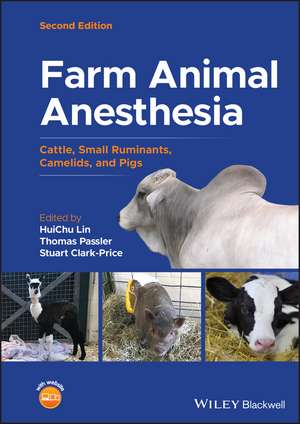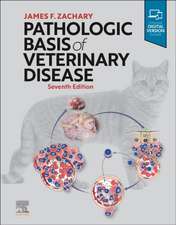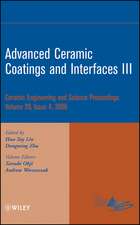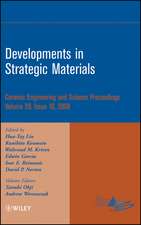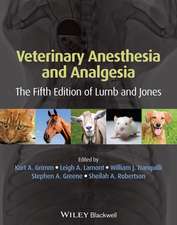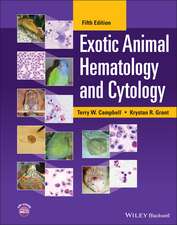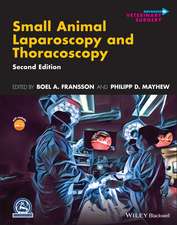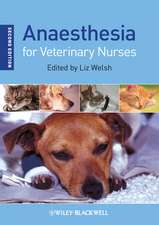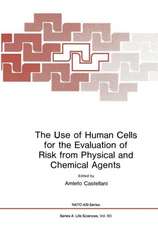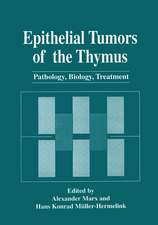Farm Animal Anesthesia – Cattle, Small Ruminants, Camelids, and Pigs
Autor H Linen Limba Engleză Hardback – 30 mar 2022
A completely revised and updated reference for farm animal anesthesia, sedation, and pain management The newly revised Second Edition of Farm Animal Anesthesia: Cattle, Small Ruminants, Camelids, and Pigs is a practical and easy-to-use manual for techniques associated with anesthesia and pain management in farm animal species. The new edition incorporates advances in surgical and diagnostic techniques, with the latest drugs and equipment, updated images, and new technique descriptions added throughout the book. Farm Animal Anesthesia offers additional and updated information on drug combinations and anesthetic techniques relevant to small ruminants and potbellied pigs, reflecting their growing popularity. New chapters and topics on paralytic drugs for complete muscle relaxation, use of ventilators for advanced and complex surgeries, updated local and regional anesthetic techniques, and comprehensive standing surgery and diagnostic procedures have been added. Readers will also benefit from access to a companion website with video clips demonstrating local and regional anesthetic techniques described within. The book also includes: * A thorough introduction to general preanesthetic considerations for ruminants, camelids, including alpacas and llamas, and potbellied pigs * A comprehensive exploration of commonly used preanesthetics and injectable anesthetics, including anticholinergics, sedatives, tranquilizers, analgesics, and injectable anesthetics * Practical discussions of standing sedation and chemical restraint, including new drug combinations for reliable restraint and remote drug delivery * In-depth description of the use of neuromuscular blocking drugs and monitoring in farm animals * Complete review of regulatory and legal considerations of anesthetics and analgesics used in farm animals Farm Animal Anesthesia is an indispensable resource for farm animal practitioners, veterinary surgeons, veterinary anesthetists, and researchers, as well as for veterinary students and residents in surgery and anesthesia.
| Toate formatele și edițiile | Preț | Express |
|---|---|---|
| Paperback (1) | 706.11 lei 39-44 zile | |
| Wiley – 12 iun 2014 | 706.11 lei 39-44 zile | |
| Hardback (1) | 1117.12 lei 3-5 săpt. | +41.32 lei 7-13 zile |
| Wiley – 30 mar 2022 | 1117.12 lei 3-5 săpt. | +41.32 lei 7-13 zile |
Preț: 1117.12 lei
Preț vechi: 1175.92 lei
-5% Nou
213.76€ • 222.75$ • 176.99£
Carte disponibilă
Livrare economică 13-27 martie
Livrare express 27 februarie-05 martie pentru 51.31 lei
Specificații
ISBN-10: 1119672546
Pagini: 336
Dimensiuni: 178 x 260 x 20 mm
Greutate: 0.87 kg
Ediția:2nd Edition
Editura: Wiley
Locul publicării:Hoboken, United States
Descriere
A completely revised and updated reference for farm animal anesthesia, sedation, and pain management
In the newly revised Second Edition of Farm Animal Anesthesia: Cattle, Small Ruminants, Camelids, and Pigs, distinguished veterinarians Drs. HuiChu Lin and Paul Walz deliver a practical and easy-to-use manual for techniques associated with anesthesia and pain management in farm animal species. The authors incorporate advances in surgical and diagnostic techniques, with the latest drugs and equipment, updated images, and new technique descriptions added throughout the book.
Reflecting their newfound popularity, Farm Animal Anesthesia offers additional and updated information on drug combinations and anesthetic techniques relevant to small ruminants and potbellied pigs. New chapters and topics on paralytic drugs for complete muscle relaxation, ventilators for advanced orthopedic and ophthalmological surgeries, updated local and regional anesthetic techniques, and comprehensive standing surgery and diagnostic procedures have been added.
Readers will also enjoy access to a companion website with video clips demonstrating techniques described within. The book also includes:
- A thorough introduction to general preanesthetic considerations for ruminants, camelids, including alpacas and llamas, and potbellied pigs
- A comprehensive exploration of commonly used preanesthetics and injectable anesthetics, including anticholinergics, sedatives, tranquilizers, analgesics, and injectable anesthetics
- Practical discussions of standing sedation and chemical restraint, including new drug combinations for reliable restraint and remote drug delivery
- In-depth treatments of the use of neuromuscular blocking drugs and monitoring in farm animals
Perfect for farm animal practitioners, veterinary surgeons, veterinary anesthetists, and researchers, Farm Animal Anesthesia is also an indispensable resource for veterinary students and residents in surgery and anesthesia seeking a one-stop, practical reference to farm animal anesthesia.
Notă biografică
The editors HuiChu Lin, DVM, MS, DACVAA, is Professor of Anesthesia in the Department of Clinical Sciences, College of Veterinary Medicine at Auburn University in Auburn, Alabama, USA. Thomas Passler, DVM, PhD, DACVIM-LA, is Professor of Food and Fiber Animals in the Department of Clinical Sciences, College of Veterinary Medicine at Auburn University in Auburn, Alabama, USA. Stuart Clark-Price, DVM, MS, DACVIM-LA, DACVAA, CVA, is Associate Professor of Anesthesia in the Department of Clinical Sciences, College of Veterinary Medicine at Auburn University in Auburn, Alabama, USA.
Cuprins
Contributing Authors Preface Chapter 1. Preanesthetic Considerations HuiChu Lin Positioning Ruminal tympany Regurgitation Salivation Malignant hyperthermia Differences in sensitivity to anesthetics Preanesthetic preparation References Chapter 2. Commonly Used Preanesthetics HuiChu Lin Acepromazine (phenothiazine derivatives) Droperidol and azaperone (butyrophenone derivatives) Detomidine, dexmedetomidine, medetomidine, romifidine, and xylazine (alpha2 agonists) Atipamezole, tolazoline, yohimbine, and vatinoxan (alpha2 antagonists) Diazepam and midazolam (benzodiazepine derivatives) Chloral hydrate References Chapter 3. Standing Sedation and Chemical Restraint HuiChu Lin Cattle Small ruminants and camelids Swine References Chapter 4. Injectable Anesthetics and Field Anesthesia HuiChu Lin Injectable anesthetics Ketamine Telazol Alfaxalone Guaifenesin Field anesthesia Cattle Small ruminants and camelids Swine References Chapter 5. Neuromuscular Blocking Agents Stuart Clark-Price Physiology of the neuromuscular junction Mechanism of action of NMBA Depolarizing neuromuscular blocking agents Non-depolarizing neuromuscular blocking agents Clinically useful NMBA Atracurium Cis-atracurium Vecuronium Rocuronium Monitoring of NMBA action Reversal of NMBA References Chapter 6. Inhalation Anesthesia and Use of Ventilator HuiChu Lin Cattle Small ruminants and camelids Swine Use of Ventilators References Chapter 7. Perioperative Monitoring and Management of Complications HuiChu Lin Perioperative monitoring Supportive fluid therapy Positioning Recovery Perioperative complications Regurgitation and aspiration pneumonia Airway obstruction Ruminal tympany/bloat Salivation Hypoventilation Cardiac arrhythmias Hypotension Hypothermia Malignant hyperthermia Postanesthetic neuromyopathy Cardiovascular collapse References Chapter 8. Local and Regional Anesthetic Techniques Jessica Rush and Jenna Stockler Local anesthetic agents Anesthesia for dehorning Anesthesia for the eye and eyelids Nasal anesthesia Anesthesia for reproductive procedures and for cessation of straining Caudal epidural anesthesia Continuous caudal epidural anesthesia Internal pudendal nerve block Dorsal penile nerve block Sacral paravertebral nerve block Lumbosacral epidural anesthesia Anesthesia for laparotomy Line block Inverted L block Proximal paravertebral block Distal paravertebral block Anesthesia for udder and teats Anesthesia of the limbs Castration References Chapter 9. Anesthetic Management of Specific Procedures Benjamin Newcomer Urogenital surgery in the male Castration Penile papilloma Persistent frenulum Penile translocation Epididymectomy Vasectomy Urogenital surgery in the female Cesarean section Ovariectomy Vaginal prolapse Perineal laceration Surgical disorders of the abdomen Laparotomy Disorders of the forestomachs Displacements and volvulus of the abomasum Small intestine disorders (intussusception, intestinal volvulus, intestinal obstruction) Urolithiasis and bladder rupture Umbilical hernias Musculoskeletal indications Dehorning Claw amputation and facilitated ankylosis Excision of interdigital fibromas Teeth Floating Tail docking Rectal prolapse Wounds, lumps, bumps, and abscesses Wound management Ocular squamous cell carcinoma Enucleation Entropion Abscess removal for caseous lymphadenitis References Chapter 10. Pain Management for Farm Animals HuiChu Lin Local anesthetics Systemic pain management Opioid analgesics Nonsteroidal anti-inflammatory drugs Alpha-2 agonists Ketamine Gabapentin Drug combinations for pain management Constant rate infusion Local or regional analgesia Caudal epidural analgesia Lumbosacral epidural anesthesia Intra-articular analgesia References Chapter 11. Fluid Therapy Manuel F. Chamorro and Paul H. Walz General considerations Physiology of body fluids Patient assessment Fluid and electrolyte therapy in the perioperative period Quantity and rate of fluid administration Fluid type selection Fluid therapy in cases of calf diarrhea Fluid therapy in cases of acute ruminal acidosis (grain overload) Fluid therapy in cases of Hepatic lipidosis/Ketosis/Pregnancy toxemia Fluid therapy in cases of abomasal and small intestinal disorders Fluid therapy for cases of sepsis (septic peritonitis, septic omphalitis, etc.) Fluid therapy in cases of urinary tract obstruction/rupture Whole blood transfusions Method of administration Monitoring fluid administration References Chapter 12. Regulatory and Legal Considerations of Anesthetics and Analgesics Used in Food Producing Animals Thomas Passler Alpha-2 agonists and antagonists Barbiturates Benzodiazepines Dissociative anesthetics Local anesthetics Opioids Non-steroidal anti-inflammatory drugs (NSAIDs) Phenothiazine Derivatives Propofol References 13. Euthanasia of Farm Animals Thomas Passler Considerations prior to Euthanasia The Process of Euthanasia Methods of euthanasia Injectable euthanasia agents Physical methods Adjunctive and other methods of euthanasia Considerations Subsequent to Euthanasia References
